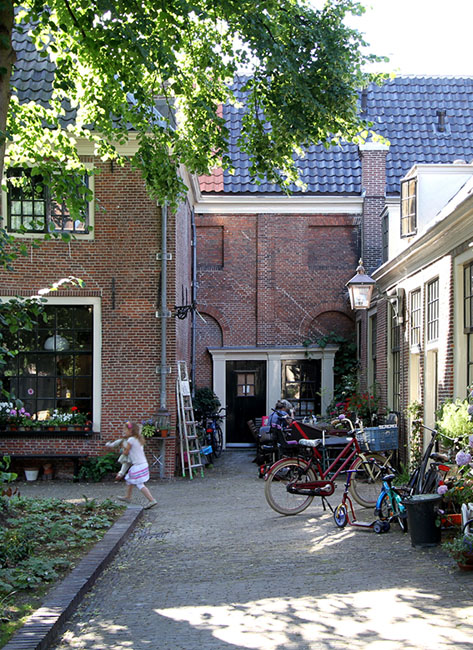Proveniershof
Haarlem (NL)
Samenvatting
Wie op een mooie zomerse dag door de Aspoort de beschutte Proveniershof binnenloopt, treft bewoners op stoeltjes voor hun huisjes, of picknickend op het grasveld in het midden van de hof. In de winter is het stil en leeg. De bebouwing oogt allesbehalve strak: rooilijnen en haakse hoeken wijken, beukmaten verschillen. Toch wordt alles verenigd door de metselwerk gevels, doorlopende zadeldaken, het ritme van houten deuren en ramen en de gemeenschappelijke tuin. Nieuwsgierig maken de binnenhoeken: de huizenrijen en entrees lijken hier koud tegen andere gevels gebouwd, zonder rekening te houden met monumentale pilasters en blindnissen, die onderdeel zijn van een oudere, classicistische gevelcompositie. Hier spreekt een lange geschiedenis.
De oorsprong van de Proveniershof is het St. Michaël klooster, gesticht in 1414, waar vrouwen van goede komaf leefden. Na de Reformatie werd het complex in 1592 het oefenterrein van de schutters van de Nieuwe of St. Joris Doelen. Hiervoor werden in de noordoosthoek verenigingsruimten gebouwd met een representatieve renaissancegevel en een grote zaal. De bebouwing langs de randen was georiënteerd op de stad en hoorde niet bij de schutterij. In 1681 werd het complex op initiatief van het stadsbestuur verbouwd tot een ‘Heerenlogement’, waar hoogwaardige gasten van de stad met hun gevolg, koetsen en paarden konden neerstrijken. Toen dit niet rendabel bleek, kreeg het in 1706 opnieuw een woonbestemming als ‘Proveniershuis’: een vorm van ouderenhuisvesting waar men zich inkocht tegen een vast bedrag, afhankelijk van leeftijd en omstandigheden, en vervolgens levenslang kost en inwoning genoot.



